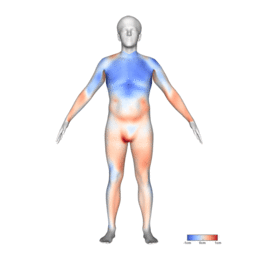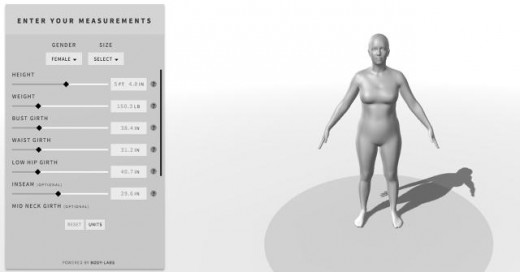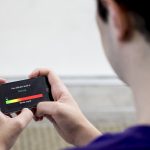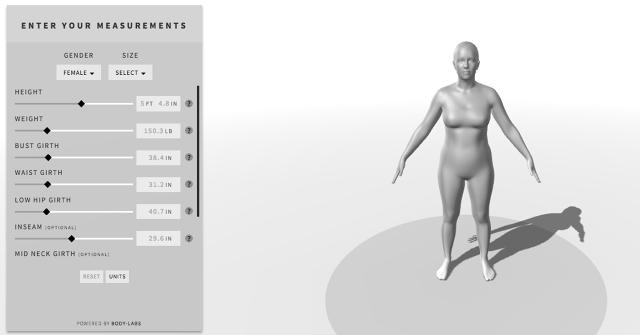physique Labs wants to bring in The era Of Free 3-D physique Scanning
This startup’s technology could to find purposes in the whole thing from model to health.
April 28, 2015
three-D scanning is broadly used to ingest physical objects similar to furniture into digital files. As its name suggests, new york-based totally startup physique Labs wants to do the same with human bodies. but unlike a espresso desk, your physique adjustments, and a scan these days will not be exactly the identical as a scan made three weeks ago—which is strictly what physique Labs is reckoning on. with the aid of monitoring your physique’s subtle adjustments, physique Labs is exploring just one of its expertise’s purposes to build a happier, healthier you.
the company produces tool that builds a digital physique edition from a three-D scan taken by using 3-D cameras. that can be an opulent proposition: the 3-D scan meeting proven on this video of body Labs’ operations is an eight-digital camera adaptation with the aid of the U.S. army that prices upwards of $30,000.
however physique Labs is developing software for scans made with the aid of the three-D cameras coming out on smartphones, capsules, and laptops subsequent 12 months. And when people use their home devices to scan themselves and add them into BodyHub, physique Labs’ on-line portal, they are able to see for themselves how their physique changes from scan to scan.
“we can be among the greatest of huge data companies,” says CEO and cofounder bill O’Farrell. “Our lengthy-term belief is that we will be able to be the creator and curator of everyone’s physique adaptation. And we never want to cost for it.”
like all biometric element, a physique scan is data, and bulk data are precious. body Labs’ largest customer (that it will possibly discuss) is the U.S. military, which has a nearly $1 million care for the corporate to make use of 12,000 body scans (two-thirds of which are male, one-1/3 female) with a purpose to enhance uniforms and physique armor. Designers took the physique Labs scan knowledge and created new patterns to toughen fit and better spread weight—patterns becoming the maximum number of squaddies with a minimum number of sizes to save lots of cost. the military desires to grasp that as much as the 99th percentile of its infantrymen can properly put on its armored vests or get out of a tank hatch.
“What we are doing for lots of attire firms is slicing down on the sample course of. They still make paper patterns that they minimize out and put on fashions. we can make a computer-aided design adaptation as an alternative,” says O’Farrell.
unless you’ve got an awfully skilled eye, it’s very time-ingesting for fashion designers to test patterns on 10 or one hundred our bodies unless they in finding the common human geometry, provides body Labs cofounder and VP of product design, Dr. Eric Rachlin. And even then, they end up with averages that sit down in the course of the physique vary, but don’t in fact resemble actual bodies. they just have representative fashions for measurement four, dimension 6, and dimension 12.
“Who’s the scale 12? smartly, that’s a adaptation. And any individual will see that adaptation and say, ‘whats up, wait, no one looks like that,’” says Rachlin. “That’s just now not how the physique works.”
physique Labs’ scans are currently restricted to superficial monitoring of the body. but with these days’s—and tomorrow’s—3D cameras, the corporate is creating the device to take scans from shopper gadgets and turn them into fashions for other firms to use. it is made a few demos displaying how the technology can be utilized in fields such as digital animation, well being, and type. Rachlin admits it’s tempting to imagine developing software for each field the startup is eyeballing, however that will take physique Labs in a limiting direction—so it chose to unencumber an API it calls the BodyKit for different corporations to play with.
“We’d love to point out the arena what we’re able to, however we’re no longer specialists fashionable and apparel, for example,” says Rachlin. “It doesn’t make experience for us to do it when others can build it out.”
protecting A near-naked Mini-Me
I met O’Farrell and Rachlin at a demo evening again in February when they announced the BodyKit API and offered to scan guests with their massive army scanner. What might I do however volunteer? (after which accede to ABC reporter Tina Trinh’s request to film the scan for a section.) Weeks later, body Labs loaded the scan right into a MakerBot three-D printer and printed up . . . me. A tiny 6-inch, 1/a hundred version of me.
I brought Tiny Me to the quick company offices and, as expected, it (he?) was once swarmed by way of my coworkers. where may they get one? is that this truly what I gave the impression of? Did they scan me bare? they didn’t—I selected to scan in my lingerie—however the crowd gawking at Tiny Me started to get uncomfortable.

This was once no longer a sparsely chosen triptych of pictures for Tinder. This was not me flexing in a waist-excessive mirror selfie. When anyone picks up Tiny Me, I haven’t any keep watch over over how my body is viewed. i’m now not framed from flattering angles or reshaped by way of trendy garments: Like Hermione asks in Harry Potter and the Prisoner of Azkaban, I could no longer assist obsessing over questions like “Is that how I in reality appear from the again?”
I wish to assure folks that Tiny Me was once scanned after I was weathering February via consuming my feelings, and that I spent two weeks going to the health club before I demanded a 2nd scan (you can see the comparison in the GIF under). I wish to excuse how I seem to be as a result of, in a method, the honesty of a three-D body scan is a nightmare for folks with physique anxiousness—which is everyone, together with me.
however there is something freeing about seeing your weird physique in the goal, trustworthy curves of a 3-d scan—and imagining how in a similar fashion everybody sees their own bizarre body. once we all get scanned and have our own specified set of physique dimensions, it’s going to now not matter that I keep failing to fit into old shirts: i’ll upload my stats to an internet vendor and it will print me out a shirt that sits proper on me and mistaken on just about everyone else. i will get scanned morning and night time to peer how my physique shifts through the day. And finally we will be able to all see that there aren’t measurement 0 women and medium males—there’s an infinite spectrum of weird, great bodies.
ready For the world To seize Up
Rachlin used to be a graduate pupil in 2010 when he met professor Michael Black, who specializes in pc vision. O’Farrell, a graduate of Brown college, the place Black taught, had started and sold a couple of firms, together with the company of Science and art, which created the After results special-results software that is now sold by Adobe. Black brought O’Farrell back to meet Rachlin and Alex Weiss, the latter of whom would change into the fourth cofounder and VP of software construction.
Black was once appointed to the Max Planck Institute of wise techniques in Germany in 2010 with a $5 million supply to proceed his research on 3-D scanning. With nonexistent demand for 3-d body biometrics and work left to do on its software, physique Labs decided to stay in development with cells in big apple and Germany.
however considering the fact that then, two issues came about: An ecosystem emerged around implementing 3D, and folks changed into obsessed with biometrics. health trackers changed into a factor. In gaming and leisure, Microsoft launched the Kinect in 2010 and up to date it in 2014; facebook sold Oculus Rift in March 2014. the market for 3D scanning erupted in a single day as Occipital’s construction Sensor exterior iPad scanner blew via its Kickstarter intention in a day in September 2013, topping out at 1200% funded with $1.2 million raised. Now, Google’s venture Tango has leaped into the fray and we must expect more than one-camera stereoscopic 3-d in our smartphones, capsules, and laptops as early as subsequent 12 months, O’Farrell says.

client demand for both biometrics and 3-D functionality has risen while the physique Labs team has been hunkered right down to fantastic-tune its instrument—but now that the tech is possible, is the corporate scared of any person catching up and competing with more cost effective options?
“The scan is just a level cloud. while it’s something it’s worthwhile to do with simply any scanner, i think it’s complicated to take a scan and make it helpful. We’re hopeful that between the expertise we’ve developed, the learning we’ve had, and the patents we’ve filed, we’ll maintain our head start,” says O’Farrell.
Then there’s the protection question: Is body Labs fearful of getting hacked?
“We’re aware of the security want when webhosting biometrics like you possibly can any sensitive knowledge. could we be hacked? certain. If the Pentagon can get hacked, sure,” says O’Farrell. “We’re hyperaware, but the value will not be the same as checking account information.”
“It’s sensitive, but are the physique scans extra revealing than facebook information?” says Rachlin.
physique Labs is already web hosting around 2,500 physique scans on its BodyHub repository, which is currently limited to physique Labs’ business-to-industry contracts. but over time, a good way to exchange, says Rachlin, and so they hope that corporations making apps from their BodyKit API will build apps on prime of the BodyHub portal. Ideally, a person with a BodyHub account would be able to go to a personal coach and the teacher might use their scan information to focus on particular parts of the physique to track adjustments over time as the individual continues uploading scans to BodyHub.
Gyms, health professionals, and health apps have plenty of attainable to use physique Labs’ scan information (“can you think about when Equinox has it?” says O’Farrell), but the first field to harness its body scans it will be apparel and consumer style, says Rachlin. certainly, online clothing retailer Woodies has already constructed body Labs scan tech into its website online, allowing consumers to fill in their own measurements to get a custom-made and geared up T-shirt. extra retailers may practice in as quickly as the following couple months, says Rachlin.
There are beneficial avenues in entertainment, too. Rachlin believes that 3D scanning will fortify personality introduction in video games, letting gamers scan themselves into the motion. however more thrilling is the chance to animate these three-D models. With accurate scans and tool sophisticated to mirror right kind movement of muscles and elements, animators could animate physique fashions in an instant as a substitute of the laborious course of of creating skeletal wireframe fashions that work with a physics engine and then growing skins to put on top of the wireframes. whereas this would almost definitely require lots of man-hours growing new physics engines and tool, it is usually quicker and cheaper than the current movement-seize process.
physique Labs has played round with rudimentary animation, taking existing body models scanned in and changing their poses. It’s difficult to get the our bodies to behave like humans do. “It’s about getting movement and quantifying the jiggly bits of the physique, so that you can speak,” says Rachlin. “The model’s going to get extra sophisticated over time, and one day, I for sure think that we’re going as a way to seem to be within and spot the fats distribution and skeletal system.”
at the Max Planck Institute, physique Labs researchers had been in a position to take a version of their physique scanner into the fitness center and record how the physique bounced relating to health. body fats and muscle are dispensed in a particular means and must move in a selected approach: should you punch a part of the abdomen and it doesn’t transfer, that’s unhealthy, says Rachlin.

and then there’s health. physique Labs just released a consumer-dealing with demo product, a widget for folks to input their scans and calculate their body mass index (BMI), a standard metric for roughly calculating weight in opposition to the inhabitants’s reasonable.
“the explanation people are obsessive about weight is that it’s one thing that you may measure. we want something better for folks to think about, and ideally better than the BMI,” says Rachlin. “we wish individuals to assume with regards to body shape and physique geometry, its shapes and curves. The fundamental means wherein physique shapes range is the more or less well being monitoring we had in thoughts.”
just like 23AndMe’s observe of selling anonymized chunks of biometric data to companies and researchers, physique Labs is taking into account selling anonymized units of body scans. but in the intervening time, it does not need to worry about being self-sustaining.
“It doesn’t make feel for us to be winning. It is smart for us to develop,” says Rachlin. “With emerging devices demonstrating the potential of the 3-D world, it is a good time to construct more alternatives for customers to make bodies.”
fast company , learn Full Story
(219)














